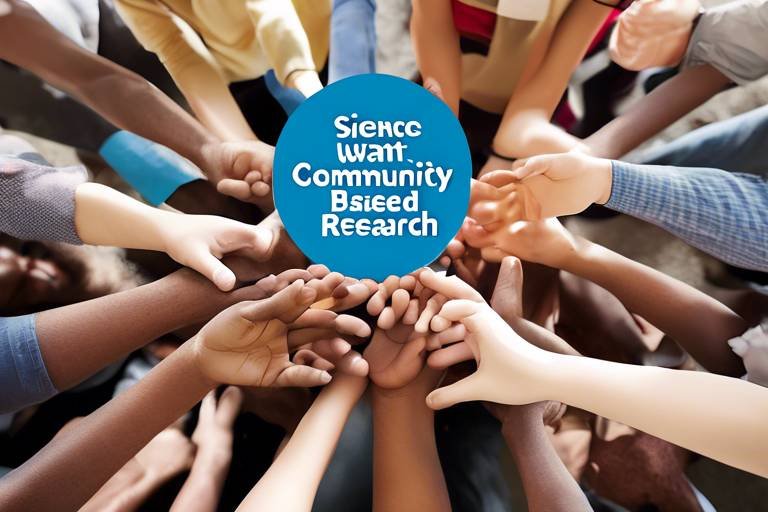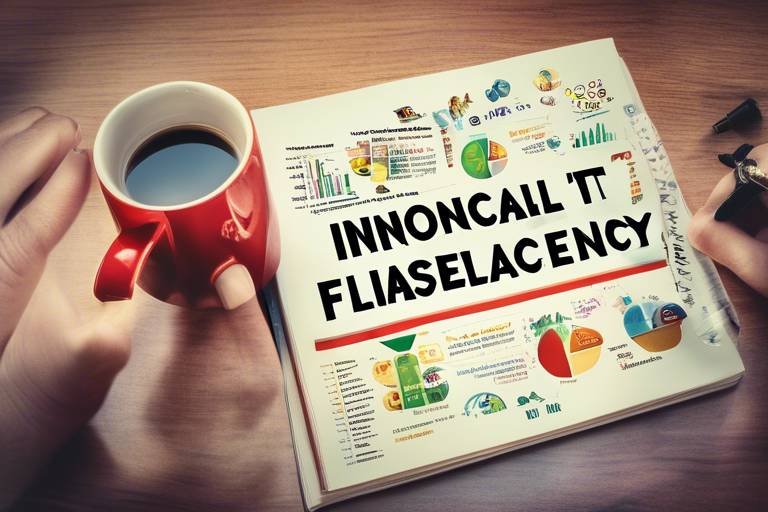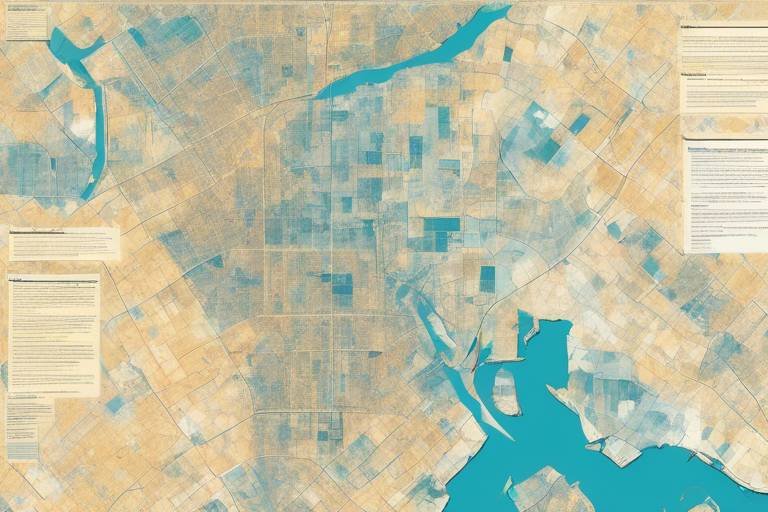How to Develop Research-Based Educational Resources
Creating educational resources that are grounded in research is not just a good practice; it's a necessity for anyone serious about enhancing the learning experience. Imagine trying to build a house without a solid foundation—your educational resources are no different. They need to be based on sound research to ensure they meet the diverse needs of learners and effectively support the teaching process. In this article, we will explore the essential steps and strategies for developing these impactful resources, ensuring they are not only informative but also engaging and relevant.
Educational research is the backbone of effective teaching and learning. It provides insights into what works and what doesn’t in educational settings. By delving into research, educators can uncover strategies that enhance student engagement, improve retention, and foster a deeper understanding of the material. This section will discuss the significance of research in shaping effective educational practices and resources, emphasizing that without this foundation, the risk of creating ineffective materials increases dramatically.
Recognizing the specific needs of learners is crucial for developing educational resources that truly resonate. Think about it: how can you create something valuable if you don't even know who your audience is? This section delves into methods for assessing learner requirements and tailoring resources accordingly. By understanding the unique backgrounds, interests, and challenges of your learners, you can ensure that your resources are not only relevant but also impactful.
Needs assessments are vital for understanding educational gaps. They help you identify what your learners already know and what they need to learn. A well-conducted needs assessment can guide the entire development process, ensuring that the resources you create fill these gaps effectively. This subsection outlines various approaches to conducting effective needs assessments within educational settings.
Surveys and questionnaires are practical tools for gathering data about learner needs. When designed thoughtfully, they can provide valuable insights into the preferences and challenges faced by students. To design effective surveys, consider the following:
- Keep questions clear and concise to avoid confusion.
- Use a mix of open-ended and closed questions to gather both quantitative and qualitative data.
- Ensure anonymity to encourage honest feedback.
Implementing these tools can help you collect relevant information from learners, making it easier to tailor educational resources to their needs.
Focus groups provide qualitative insights into learner needs that surveys sometimes miss. Facilitating a focus group allows you to engage directly with learners, encouraging them to share their thoughts and experiences regarding educational materials. This part discusses how to facilitate focus groups to gather in-depth feedback on educational resources. By creating a comfortable environment where learners feel safe to express their opinions, you can gain invaluable insights that shape your resource development.
Once you've gathered data through needs assessments, the next step is analyzing this information. Data analysis is essential for interpreting needs assessment results, helping you identify trends and patterns that inform the development of educational resources. This subsection explores techniques for analyzing data, such as:
- Statistical analysis for quantitative data.
- Thematic analysis for qualitative feedback.
- Comparison of learner needs across different demographics.
By employing these techniques, you can make informed decisions that enhance the relevance and effectiveness of your educational materials.
Designing educational resources requires a blend of creativity and adherence to research principles. It's not just about making things look pretty; it's about ensuring that the content is engaging, informative, and meets the identified needs of learners. This section outlines key considerations for creating engaging and effective educational materials, including the importance of clarity, accessibility, and interactivity in resource design.
Integrating evidence-based practices enhances resource effectiveness significantly. This subsection discusses how to identify and implement these practices in educational resource design. By grounding your resources in proven strategies, you can ensure they are more likely to achieve desired learning outcomes.
Technology plays a crucial role in resource development. With the right tools, you can create interactive, multimedia-rich resources that captivate learners. This part examines various technological tools and platforms that can enhance the creation and delivery of educational resources, from learning management systems to content creation software.
Q1: What is the first step in developing educational resources?
A1: The first step is to conduct a needs assessment to understand the specific needs of your learners.
Q2: How can I ensure my resources are engaging?
A2: Incorporate interactive elements, utilize multimedia, and design with clarity in mind to keep learners engaged.
Q3: Why is educational research important?
A3: Educational research provides evidence-based insights that inform effective teaching practices and resource development.
Q4: What tools can I use for data analysis?
A4: You can use various statistical software for quantitative data and thematic analysis techniques for qualitative feedback.

Understanding Educational Research
Educational research is more than just a collection of data; it's the backbone of effective teaching and learning strategies. When we delve into educational research, we uncover a treasure trove of insights that can shape the way we develop resources for learners. The significance of research in education cannot be overstated, as it provides a framework for understanding what works and what doesn't in various educational contexts. By grounding our resources in solid research, we ensure that they are not only relevant but also effective in meeting the diverse needs of learners.
Imagine trying to navigate a vast ocean without a map. That’s what creating educational resources without research feels like. Research acts as our compass, guiding us toward practices that have been proven to enhance learning outcomes. It helps us understand the dynamics of different learning environments, the challenges faced by educators, and the specific needs of students. This understanding is crucial for developing resources that truly resonate with learners and facilitate meaningful engagement.
One of the key aspects of educational research is its ability to inform evidence-based practices. These practices are strategies that have been shown through rigorous research to be effective in improving student learning. By integrating these practices into our resource development process, we can create tools that are not only innovative but also grounded in reality. For instance, research might indicate that collaborative learning significantly boosts student engagement. Knowing this, we can design resources that encourage group work and peer interaction, making learning a more dynamic experience.
Furthermore, educational research helps us stay current with trends and shifts in pedagogy. As the landscape of education evolves—especially with the rise of technology and online learning—research provides insights into how these changes impact teaching and learning. It allows educators to adapt their resources to align with contemporary practices and the needs of today’s learners.
To illustrate the impact of educational research on resource development, consider the following table that outlines various research-backed strategies and their benefits:
| Research-Backed Strategy | Benefits |
|---|---|
| Active Learning | Enhances critical thinking and retention of information. |
| Formative Assessment | Provides ongoing feedback to improve learning outcomes. |
| Differentiated Instruction | Addresses the diverse needs of learners, promoting inclusivity. |
| Technology Integration | Engages students and facilitates access to a wealth of resources. |
In conclusion, understanding educational research is pivotal for anyone involved in developing educational resources. It not only enriches our knowledge but also empowers us to make informed decisions that can significantly enhance the teaching and learning experience. By leveraging research, we can create resources that are not only effective but also inspiring, ensuring that learners are equipped to thrive in their educational journeys.

Identifying Learner Needs
Recognizing the specific needs of learners is crucial when developing educational resources that truly resonate. Think of it like tuning a musical instrument; if you don’t know the exact pitch, your song will never sound right. By identifying learner needs, you can create resources that not only engage but also empower students to reach their full potential. So, how do we go about this? Well, it starts with a clear understanding of who your learners are and what they require to succeed.
One effective way to gauge learner needs is through needs assessments. These assessments act as a compass, guiding educators toward the direction they need to take in resource development. They help pinpoint gaps in knowledge, skills, and attitudes that learners may have, ensuring that the resources created are not just generic materials, but tailored solutions that address specific challenges faced by students.
When it comes to conducting needs assessments, there are several approaches you can take. Each method has its own strengths, and often, a combination of these methods yields the best results. Here are a couple of popular strategies:
- Surveys and Questionnaires: These tools can be designed to gather quantitative data from a larger audience. They allow you to ask targeted questions that can help you understand learners' preferences, challenges, and motivations.
- Focus Groups: Conducting focus groups can provide qualitative insights that surveys may miss. This method allows for in-depth discussions with a small group of learners, offering a platform for them to express their thoughts and feelings about existing educational resources.
Both surveys and focus groups serve as valuable resources in identifying learner needs, but they should be approached thoughtfully. For instance, when designing surveys, it’s essential to keep questions clear and concise to avoid confusion. On the other hand, focus groups require skilled facilitation to ensure that all voices are heard and that the discussion remains productive.
Surveys and questionnaires can be incredibly powerful if executed correctly. They can be distributed online or in person, making them accessible to a wide range of learners. The key is to ask the right questions—questions that not only assess what learners know but also uncover their attitudes toward learning. Here’s a simple structure you might consider:
| Question Type | Purpose |
|---|---|
| Multiple Choice | To gauge preferences or knowledge levels. |
| Rating Scale | To measure attitudes or satisfaction. |
| Open-Ended | To gather detailed feedback and insights. |
By combining various question types, you can create a comprehensive picture of your learners’ needs, which will ultimately inform the development of your educational resources.
Focus groups, on the other hand, dive deeper into the qualitative aspects of learner needs. They provide a space for learners to share their experiences, challenges, and suggestions in a more conversational setting. When facilitating a focus group, it’s vital to create a comfortable environment where participants feel safe to express their thoughts openly. This can lead to unexpected insights that surveys might not capture.
To ensure the success of focus groups, consider the following tips:
- Set clear objectives: Know what you want to achieve from the discussion.
- Encourage participation: Prompt quieter members to share their thoughts.
- Record the session: This allows for accurate data capture and analysis later on.
In summary, identifying learner needs is a multi-faceted process that involves both quantitative and qualitative research methods. By conducting thorough needs assessments through surveys and focus groups, educators can create resources that are not only effective but also resonate deeply with learners, ultimately enhancing their educational experience.

Conducting Needs Assessments
Conducting needs assessments is a crucial step in the process of developing educational resources. It allows educators to identify the gaps in knowledge and skills among learners, which ultimately informs the creation of tailored materials that meet their specific needs. Think of it as a roadmap; without understanding where your learners are starting from, it's nearly impossible to guide them to their destination effectively. So, how do we go about conducting these assessments?
First and foremost, it's essential to recognize that needs assessments can take various forms, each offering unique insights. One effective approach is to utilize surveys and questionnaires. These tools can be designed to gather quantitative data, allowing educators to analyze trends and patterns in learner needs. When crafting these instruments, it’s vital to ensure that the questions are clear, concise, and relevant to the educational goals. For instance, you might ask questions that assess prior knowledge, preferred learning styles, and specific challenges learners face. This structured approach helps in collecting valuable data efficiently.
Another method worth considering is organizing focus groups. Unlike surveys, focus groups provide a platform for qualitative insights, where learners can express their thoughts and feelings in a more open and interactive environment. Facilitating a focus group involves guiding discussions around specific topics related to the educational resource being developed. By encouraging participants to share their experiences and suggestions, educators can gain a deeper understanding of the learner's perspective. This method not only uncovers hidden needs but also fosters a sense of community among participants, making them feel valued in the resource development process.
Once the data has been collected through these methods, the next step is to analyze it effectively. This is where the magic happens! Data analysis can be as simple as looking for recurring themes in qualitative feedback or as complex as statistical analysis of survey results. For example, you might categorize responses to identify common challenges that learners face, which can then be prioritized in the resource development process. The goal here is to transform raw data into actionable insights that guide your educational resource design.
In conclusion, conducting needs assessments is not just a checkbox in the resource development process; it's an ongoing journey of discovery. By employing a combination of surveys, focus groups, and thorough data analysis, educators can ensure that the resources they create are not only relevant but also highly effective in addressing the unique needs of their learners.
- What is a needs assessment? A needs assessment is a systematic process to determine and address gaps between current conditions and desired conditions, particularly in educational settings.
- Why are needs assessments important? They help identify specific learner requirements, ensuring that educational resources are tailored to meet those needs effectively.
- How can I collect data for a needs assessment? Data can be collected through surveys, questionnaires, focus groups, interviews, and observations.
- What should I do with the data collected? Analyze the data to identify trends and key insights, which will inform the development of your educational resources.

Surveys and Questionnaires
When it comes to gathering insights about learner needs, emerge as powerful tools in the educator's arsenal. They allow us to tap into the minds of our students, providing a window into their thoughts, preferences, and challenges. But how do we design these instruments effectively? The key lies in crafting questions that are not only clear and concise but also engaging enough to encourage honest and thoughtful responses.
First, let's consider the structure of your survey. A well-organized questionnaire typically starts with demographic questions that help categorize responses. For example, asking about age, grade level, or previous educational experiences can provide context for the data collected. Following this, you might include a mix of closed-ended questions (like multiple-choice or Likert scale questions) and open-ended questions that allow for more detailed feedback. This combination can yield both quantitative and qualitative data, giving you a fuller picture of your learners' needs.
Here’s a simple example of how to structure your survey:
| Question Type | Example Question |
|---|---|
| Demographic | What is your grade level? |
| Closed-Ended | How confident do you feel about using technology in your studies? (1-5 scale) |
| Open-Ended | What challenges do you face when learning online? |
Once your survey is designed, the next step is implementation. Distributing your survey through various channels—be it email, social media, or even in-class—can maximize participation. Remember, the more responses you gather, the more reliable your findings will be. It's also essential to communicate the purpose of the survey to your learners. Let them know that their feedback is invaluable and will directly influence the resources and support provided to them.
After collecting the data, take the time to analyze it thoroughly. Look for trends, common themes, and surprising insights. This analysis will not only inform the development of new educational resources but will also help refine existing ones. By regularly conducting surveys and questionnaires, you create a feedback loop that ensures your resources remain relevant and effective.
In conclusion, surveys and questionnaires are not just about collecting data; they are about fostering a culture of open communication and continuous improvement in education. So, the next time you set out to create educational resources, consider how you can leverage these tools to better understand and meet the needs of your learners.

Focus Groups
Focus groups are an incredible tool for diving deep into the minds of learners, providing qualitative insights that surveys often miss. Picture this: a cozy room filled with a diverse group of individuals, all sharing their thoughts, experiences, and feelings about educational resources. This dynamic interaction creates a rich tapestry of perspectives that can illuminate the needs and preferences of your target audience. But how do you effectively facilitate a focus group to ensure you gather meaningful feedback? Let's break it down.
First and foremost, selecting the right participants is crucial. Aim for a mix of learners who represent different backgrounds, skill levels, and learning styles. This diversity will not only enrich the discussion but also ensure that the resources you develop cater to a broader audience. Once you have your group, it's time to create a comfortable environment. Make sure the setting is informal and welcoming; this encourages participants to share their thoughts openly. Remember, the goal here is to foster a conversation, not a lecture!
When leading the discussion, start with some open-ended questions to get the ball rolling. Questions like "What challenges do you face with current educational resources?" or "What features do you wish were included in your learning materials?" can spark insightful dialogue. As the facilitator, your role is to guide the conversation, keeping it on track while allowing participants to explore their thoughts freely. It's important to listen actively, noting down key points and themes that emerge throughout the discussion.
After the focus group session, it's time to analyze the data gathered. Look for common themes, unique insights, and any surprising revelations that could inform your resource development. You might even consider creating a summary table to organize the feedback, highlighting key points from the discussion. For example:
| Key Themes | Participant Insights |
|---|---|
| Resource Accessibility | Many participants expressed the need for resources that are easy to access and navigate. |
| Interactivity | Several learners highlighted the importance of interactive elements to keep them engaged. |
| Customizability | Participants desired resources that could be tailored to their individual learning styles. |
By utilizing focus groups effectively, you can gain a deeper understanding of your learners' needs, ultimately leading to the development of educational resources that truly resonate. This method not only enhances your understanding of your audience but also fosters a sense of community and involvement among learners, making them feel valued in the resource development process.
- What is a focus group? A focus group is a qualitative research method that involves guided discussions with a group of participants to gather insights on specific topics.
- How do I select participants for a focus group? Choose a diverse group representing different demographics, experiences, and learning styles to ensure a well-rounded discussion.
- What types of questions should I ask during a focus group? Start with open-ended questions that encourage discussion, and follow up with probing questions to explore participants' responses in depth.
- How can I analyze the data from a focus group? Look for common themes and unique insights, and consider using tables or charts to organize and present the findings clearly.

Analyzing Data
Once you've gathered data from your needs assessments, the next step is analyzing that data effectively. This process is crucial because it allows you to uncover patterns, identify gaps, and ultimately shape your educational resources to meet the specific needs of your learners. Think of data analysis as the lens through which you can view the educational landscape; without it, you might be navigating blindly.
There are several techniques you can employ to analyze the data you've collected. One of the most common methods is quantitative analysis, which involves statistical techniques to interpret numerical data. For instance, if you conducted a survey with multiple-choice questions, you can use software like Excel or Google Sheets to calculate averages, percentages, and even create visual representations like graphs or charts. This not only helps in understanding the overall trends but also makes it easier to present your findings to stakeholders.
On the other hand, you might also find yourself diving into qualitative analysis. This approach is particularly useful when you've gathered open-ended responses from focus groups or interviews. You can analyze these responses by identifying recurring themes or sentiments. This can be done through coding, where you categorize responses into themes and then interpret the significance of these themes in relation to your educational objectives. For example, if several learners mention they struggle with a particular topic, that’s a clear indication that your resources need to address this gap.
To make the data analysis process even more effective, consider using a
| Data Type | Analysis Method | Key Findings |
|---|---|---|
| Survey Responses | Quantitative Analysis | 70% of learners prefer interactive resources. |
| Focus Group Feedback | Qualitative Analysis | Common themes included the need for more visual aids. |
After analyzing the data, it’s essential to draw actionable conclusions. Ask yourself questions like: What do these findings imply for our current educational resources? Are there specific areas that require immediate attention? By translating data into actionable insights, you can ensure that your educational resources are not only well-informed but also impactful.
In conclusion, effective data analysis is the backbone of developing educational resources that truly resonate with learners. By combining quantitative and qualitative methods, you can create a holistic view of learner needs, enabling you to design resources that are both engaging and educationally sound. Remember, the goal is to turn data into a story that guides your resource development process.
- What is the importance of analyzing data in education?
Analyzing data helps identify learner needs, gaps in knowledge, and areas for improvement in educational resources. - What tools can I use for data analysis?
Common tools include Excel, Google Sheets, and qualitative analysis software like NVivo. - How can I ensure my data analysis is effective?
Use both quantitative and qualitative methods, and look for patterns that inform your resource development.

Designing Effective Resources
Designing educational resources is akin to crafting a masterpiece; it requires a blend of creativity, strategic planning, and a deep understanding of the target audience. When you think about it, the best resources aren’t just thrown together—they’re thoughtfully constructed with the learner's journey in mind. This means that every element, from the visuals to the content, must work harmoniously to engage and educate. But how do you ensure that your resources hit the mark? Let's dive into some key considerations that can help you create resources that are not just effective but also inspiring.
First and foremost, it's essential to incorporate evidence-based practices into your design process. This involves leveraging research findings that have been proven to enhance learning outcomes. Think of it like using a recipe that’s been tested and refined over time; you wouldn’t want to create a dish without knowing it’s been successful before! By grounding your resources in proven methods, you’re setting your learners up for success. For instance, if research shows that interactive elements boost engagement, be sure to include quizzes, discussion prompts, or hands-on activities in your materials.
Another crucial aspect to consider is the utilization of technology. In our fast-paced digital world, technology isn’t just a nice-to-have; it’s a must. Imagine trying to navigate a complex city without a GPS—frustrating, right? Similarly, educational resources that lack technological integration can leave learners feeling lost. Whether it’s through interactive online platforms, multimedia presentations, or virtual simulations, technology can significantly enhance the learning experience. For example, tools like Google Classroom or educational apps can facilitate collaboration and provide instant feedback, making learning more dynamic and engaging.
Moreover, the design should also reflect the diversity of learners. Just like a well-curated playlist has something for everyone, your educational resources should cater to various learning styles and preferences. Consider incorporating a mix of visual aids, auditory materials, and kinesthetic activities to ensure that all learners can engage with the content effectively. This approach not only fosters inclusivity but also helps in addressing the unique challenges that different learners may face.
As you design your resources, don’t forget the importance of user feedback. After all, who better to tell you what works than the learners themselves? Implementing a feedback loop can provide invaluable insights into how your resources are being received. You might consider conducting brief surveys or informal check-ins to gauge learner satisfaction and areas for improvement. This iterative process not only enhances the quality of your resources but also empowers learners by making them feel heard and valued.
Lastly, let’s not overlook the aesthetic aspect of resource design. A visually appealing resource can captivate attention and make a lasting impression. Think of it as dressing for success; a well-designed resource can draw learners in and keep them engaged. Use colors, fonts, and layouts that are not only attractive but also enhance readability and comprehension. Just as a good book cover can entice a reader, a well-designed educational resource can spark curiosity and motivate learners to dive deeper into the material.
- What are evidence-based practices? Evidence-based practices are strategies and methods that have been proven effective through rigorous research and studies in educational settings.
- How can technology enhance educational resources? Technology can provide interactive elements, facilitate collaboration, and allow for instant feedback, making learning more engaging and effective.
- Why is user feedback important in resource design? User feedback helps identify what works well and what needs improvement, ensuring that resources meet the needs of learners.
- How do I cater to different learning styles? Incorporate a variety of materials—such as visual aids, auditory content, and hands-on activities—to engage learners with diverse preferences.

Incorporating Evidence-Based Practices
When it comes to developing educational resources, is not just a suggestion; it's a necessity. These practices are grounded in rigorous research and have been proven to enhance learning outcomes. Imagine trying to build a house without a solid foundation. Similarly, without evidence-based practices, your educational resources might crumble under the weight of ineffective strategies. So, how do we go about integrating these practices into our resource development process?
First and foremost, it’s crucial to identify the research that aligns with your educational goals. This can be done by reviewing academic journals, attending educational conferences, or even engaging with online platforms that specialize in educational research. Think of this step as gathering your tools before starting a project. You wouldn’t want to find yourself halfway through a task only to realize you’re missing a crucial component!
Once you’ve gathered the necessary research, it's time to translate that knowledge into actionable strategies. For instance, if a study indicates that students learn better through collaborative activities, you might design resources that encourage group work. This could involve creating interactive assignments that require peer-to-peer engagement. In essence, you’re not just presenting information; you're crafting experiences that resonate with learners.
Another key aspect of incorporating evidence-based practices is ongoing evaluation. Just because a practice is backed by research doesn’t mean it will work perfectly in every context. It’s essential to continuously assess the effectiveness of your resources. This can be achieved through regular feedback from learners or by analyzing performance data. If something isn’t working, don’t be afraid to pivot and try a different approach. Think of it like tuning a musical instrument; sometimes, a slight adjustment can make all the difference in the world.
To further illustrate the importance of evidence-based practices, consider the following table that outlines common practices and their corresponding benefits:
| Evidence-Based Practice | Benefits |
|---|---|
| Collaborative Learning | Enhances critical thinking and social skills |
| Formative Assessment | Provides ongoing feedback and supports learning adjustments |
| Differentiated Instruction | Addresses diverse learning needs and styles |
| Use of Technology | Increases engagement and accessibility |
Incorporating evidence-based practices doesn’t just improve educational resources; it also fosters a culture of continuous improvement. This means that as educators and resource developers, we are committed to evolving our practices based on the latest research and feedback. Just like a gardener who regularly tends to their plants, we must nurture our resources to ensure they grow and thrive in the ever-changing landscape of education.
In conclusion, the integration of evidence-based practices into educational resource development is essential for creating effective and impactful learning experiences. By grounding our strategies in research, actively engaging with learners, and continually assessing our methods, we pave the way for success not only for ourselves but also for the learners we serve.
- What are evidence-based practices? Evidence-based practices are strategies that have been proven effective through rigorous research and data analysis.
- How can I find relevant research? You can find relevant research by exploring academic journals, attending educational conferences, and utilizing online educational databases.
- Why is ongoing evaluation important? Ongoing evaluation allows you to assess the effectiveness of your resources and make necessary adjustments to improve learning outcomes.
- Can evidence-based practices be applied in all educational settings? While many evidence-based practices are versatile, it’s essential to tailor them to fit the unique needs of your learners and context.

Utilizing Technology
In today's fast-paced educational landscape, technology is not just a tool; it's a game-changer. The integration of technology into educational resource development can significantly enhance both the learning experience and the teaching process. Imagine a classroom where students are not just passive recipients of information but active participants in their learning journey, thanks to the innovative use of technology. But how can we effectively utilize these tools to create impactful educational resources?
First and foremost, it's crucial to identify the right technology that aligns with your educational goals. This could range from simple tools like presentation software to more complex platforms such as learning management systems (LMS) that can track student progress and provide personalized learning paths. For instance, using an LMS allows educators to create a centralized hub for all learning materials, making it easier for students to access resources anytime, anywhere. This flexibility is vital in catering to diverse learning styles and schedules.
Moreover, incorporating multimedia elements such as videos, interactive simulations, and infographics can make learning more engaging. Visual aids not only help in breaking down complex concepts but also cater to visual learners who might struggle with traditional text-heavy resources. For example, a science lesson on the water cycle can be transformed into an interactive simulation where students can manipulate variables and observe outcomes, making the learning experience much more dynamic.
Furthermore, technology facilitates collaboration among learners. Tools like Google Classroom and Microsoft Teams allow students to work together on projects, share resources, and provide feedback to one another. This collaborative approach not only enhances learning but also builds essential skills such as teamwork and communication. Imagine students brainstorming ideas for a project using a shared digital whiteboard, where they can visually organize their thoughts and contribute in real-time, regardless of their physical location.
However, with all these advantages, it's essential to approach technology integration with a clear strategy. Not every tool will suit every learning environment. Therefore, conducting a thorough evaluation of available technologies and aligning them with the specific needs of your learners is crucial. Consider factors such as accessibility, usability, and cost-effectiveness. A well-thought-out approach ensures that the technology enhances rather than hinders the learning experience.
In conclusion, utilizing technology in developing educational resources is not just about adopting the latest gadgets or software. It’s about creating a holistic learning environment that fosters engagement, collaboration, and personalized learning experiences. By thoughtfully integrating technology, educators can transform traditional educational practices into innovative, effective, and enjoyable learning journeys.
- What types of technology can I use in educational resource development?
There are many options, including learning management systems (LMS), presentation software, multimedia tools, and collaborative platforms. - How do I choose the right technology for my needs?
Evaluate your specific educational goals, consider your learners' needs, and assess factors like accessibility and usability. - Can technology really enhance the learning experience?
Absolutely! When used effectively, technology can make learning more engaging, interactive, and personalized.
Frequently Asked Questions
- What is the importance of educational research in developing resources?
Educational research is like the compass that guides educators in creating effective resources. It provides insights into what works best for different learners, ensuring that the materials developed are not just based on assumptions but grounded in proven practices. By understanding the latest findings in education, you can craft resources that truly meet the needs of your students.
- How can I identify the specific needs of my learners?
Identifying learner needs is akin to being a detective. You need to gather clues through various methods like surveys, questionnaires, and focus groups. These tools help you uncover what your learners struggle with, what they enjoy, and how they learn best. Once you have this information, you can tailor your resources to fit their unique requirements.
- What are some effective methods for conducting needs assessments?
Conducting needs assessments can be done using a mix of quantitative and qualitative methods. Surveys and questionnaires allow you to gather numerical data, while focus groups give you rich, descriptive insights. By combining these approaches, you can paint a complete picture of your learners' needs, making your educational resources more relevant and engaging.
- How do I analyze data from needs assessments?
Data analysis is like piecing together a puzzle. You need to look for patterns and trends that emerge from your collected data. Techniques such as coding qualitative responses or using statistical software for quantitative data can help you draw meaningful conclusions. This analysis will inform your resource development, ensuring it aligns with what learners actually need.
- What are evidence-based practices, and why should I incorporate them?
Evidence-based practices are strategies that have been tested and proven effective through research. Incorporating these practices into your resource design is crucial because they increase the likelihood of achieving desired learning outcomes. By relying on what works, you can create materials that enhance the educational experience for your learners.
- How can technology enhance the development of educational resources?
Technology is like a magic wand in the world of education. It opens up endless possibilities for creating and delivering resources. From interactive online platforms to multimedia tools, technology can make learning more engaging and accessible. Embracing these tools not only enhances the quality of your resources but also meets the diverse needs of today’s learners.



















